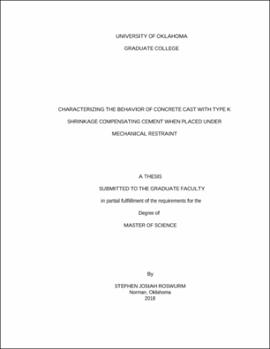| dc.description.abstract | The purpose of this research was to determine whether shrinkage-compensating concrete (SCC) made with Type K cement is capable of offsetting the effects of early age drying shrinkage, specifically when the concrete is acted upon by a stiff external restraint. The effect of restraint on SCC is important because this effect resists the expansive behavior that provides shrinkage compensation. This research was intended to improve upon the 2013 work of Seth Roswurm. The test specimens used in this experiment very closely paralleled those used in Seth Roswurm’s experiments; they consisted primarily of four sets of test specimens, each of which was cast with a unique mixture design. The test specimens included 4” diameter restrained columns, and each set consisted of three columns with varying degrees of stiffness in the restraint frame. The variation in stiffness was created by using a set of four steel restraint rods on each column, whose diameters were set at ½”, ⅝”, and ¾”. The column specimens were instrumented using Geokon® vibrating wire strain gages (VWSG), which were embedded in the concrete, and load cells, which were affixed to the top of the columns using 2” steel reaction plates mounted to the restraint rods. The most significant result of this experiment was that the data showed that SCC can be effective even under stiff boundary conditions, meaning that SCC could be viable in applications for various structures such as pavements, bridge decks, pre-tensioned and post-tensioned beams, and even residential construction. Other results drawn from these experiments included data regarding what the optimal mix design is for full shrinkage-compensation, how the SCC should be cured in order to obtain satisfactory behavior, and what kind of stress-strain curves a self-expanding material will create. | en_US |
